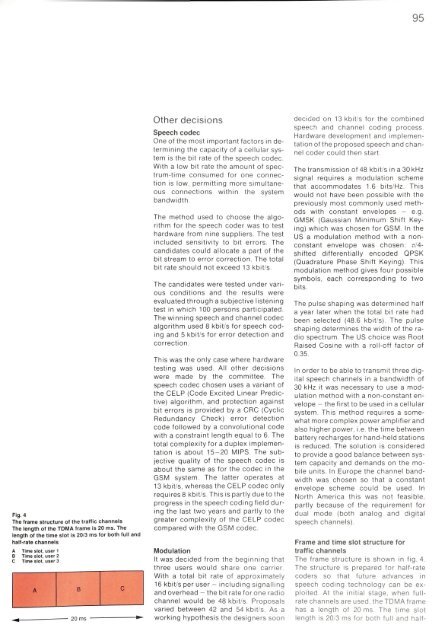Transport Network Development - ericssonhistory.com
Transport Network Development - ericssonhistory.com
Transport Network Development - ericssonhistory.com
- No tags were found...
Create successful ePaper yourself
Turn your PDF publications into a flip-book with our unique Google optimized e-Paper software.
95Fig. 4The frame structure of the traffic channelsThe length of the TDMA frame is 20 ms. Thelength of the time slot is 20/3 ms for both full andhalf-rate channelsA Time slot, user 1B Time slot, user 2C Time slot, user 3Other decisionsSpeech codecOne of the most important factors in determiningthe capacity of a cellular systemis the bit rate of the speech codec.With a low bit rate the amount of spectrum-timeconsumed for one connectionis low, permitting more simultaneousconnections within the systembandwidth.The method used to choose the algorithmfor the speech coder was to testhardware from nine suppliers. The testincluded sensitivity to bit errors. Thecandidates could allocate a part of thebit stream to error correction. The totalbit rate should not exceed 13 kbit/s.The candidates were tested under variousconditions and the results wereevaluated through a subjective listeningtest in which 100 persons participated.The winning speech and channel codecalgorithm used 8 kbit/s for speech codingand 5 kbit/s for error detection andcorrection.This was the only case where hardwaretesting was used. All other decisionswere made by the <strong>com</strong>mittee. Thespeech codec chosen uses a variant ofthe CELP (Code Excited Linear Predictive)algorithm, and protection againstbit errors is provided by a CRC (CyclicRedundancy Check) error detectioncode followed by a convolutional codewith a constraint length equal to 6. Thetotal <strong>com</strong>plexity for a duplex implementationis about 15-20 MIPS. The subjectivequality of the speech codec isabout the same as for the codec in theGSM system. The latter operates at13 kbit/s, whereas the CELP codec onlyrequires 8 kbit/s. This is partly due to theprogress in the speech coding field duringthe last two years and partly to thegreater <strong>com</strong>plexity of the CELP codec<strong>com</strong>pared with the GSM codec.ModulationIt was decided from the beginning thatthree users would share one carrier.With a total bit rate of approximately16 kbit/s per user - including signallingand overhead - the bit rate for one radiochannel would be 48 kbit/s. Proposalsvaried between 42 and 54 kbit/s. As aworking hypothesis the designers soondecided on 13 kbit/s for the <strong>com</strong>binedspeech and channel coding process.Hardware development and implementationof the proposed speech and channelcoder could then start.The transmission of 48 kbit/s in a 30 kHzsignal requires a modulation schemethat ac<strong>com</strong>modates 1.6 bits/Hz. Thiswould not have been possible with thepreviously most <strong>com</strong>monly used methodswith constant envelopes - e.g.GMSK (Gaussian Minimum Shift Keying)which was chosen for GSM. In theUS a modulation method with a nonconstantenvelope was chosen: n/4-shifted differentially encoded QPSK(Quadrature Phase Shift Keying). Thismodulation method gives four possiblesymbols, each corresponding to twobits.The pulse shaping was determined halfa year later when the total bit rate hadbeen selected (48.6 kbit/s). The pulseshaping determines the width of the radiospectrum. The US choice was RootRaised Cosine with a roll-off factor of0.35.In order to be able to transmit three digitalspeech channels in a bandwidth of30 kHz it was necessary to use a modulationmethod with a non-constant envelope- the first to be used in a cellularsystem. This method requires a somewhatmore <strong>com</strong>plex power amplifier andalso higher power, i.e. the time betweenbattery recharges for hand-held stationsis reduced. The solution is consideredto provide a good balance between systemcapacity and demands on the mobileunits. In Europe the channel bandwidthwas chosen so that a constantenvelope scheme could be used. InNorth America this was not feasible,partly because of the requirement fordual mode (both analog and digitalspeech channels).Frame and time slot structure fortraffic channelsThe frame structure is shown in fig. 4.The structure is prepared for half-ratecoders so that future advances inspeech coding technology can be exploited.At the initial stage, when fullratechannels are used, the TDMA framehas a length of 20 ms. The time slotlength is 20/3 ms for both full and half-
















